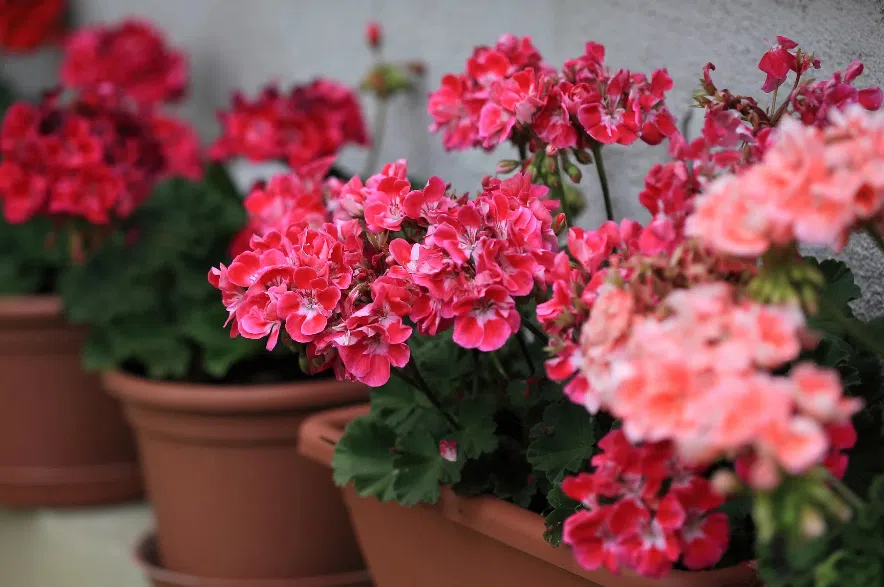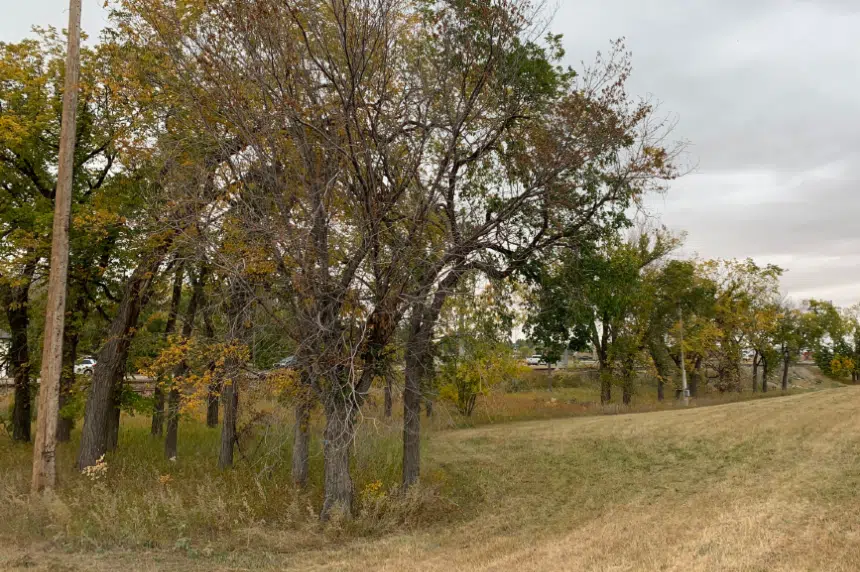Jill and Rick Van Duyvendyk answer all your gardening questions in Garden Talk on 650 CKOM and 980 CJME every Sunday morning from 9 a.m. to 11 a.m.
Here are a selection of questions and answers from the Oct. 13 show.
Q: What’s the best way to winter pots of geraniums?
A: The best thing to do is cut them back by about half to one third and then you can bring them inside — either into a garage if you have a grow light or a basement where there’s a small window. Decrease your watering, and let them go dry but not bone dry. What you’re doing is you’re you’re preserving your mother plant. The leaves are going to fall off and it is going to look a little bit lanky.
In January or February, take cuttings off that plant and root them for the next season. Rooting hormone powder for softwood cuttings will really helps to help get them rooted fast. Give them lots of light again to get them growing. Cut the mother plant back substantially
after taking cuttings so it can grow back from the base again.
Q: Can you plant perennial ferns in a pot and have them come back every year?
A: No, you can’t. They have to go in the ground. If you plant them in the pot above ground they will freeze and thaw and freeze and thaw all winter, which will be too hard on the plant. They’re really tough, especially native ferns, but make sure you are in Zone Three or Four in a very sheltered area.
You can bury the pot in the ground and then remove it every year, too, and put paper on the sides of it so that you don’t get staining from the dirt. Don’t use plastic because it needs the heat from the ground to protect it.
You could bring that pot inside a garage as long as the temperature in there has a high just above zero, and it doesn’t go down below minus 5 deg C.
Read Dutch Growers’ The Art and Science of Shade Gardening with Perennials here.
Q: Do seeds expire or can they be used the following year?
A: You can definitely use them the following year. Store them in something that is
enclosed, but make sure it’s not in plastic. I have used paper envelopes and kept them in a filing cabinet. You can keep them in a freezer as well. The germination rate will go down a little with every year that you do store them, but it might just mean like instead of a
maybe a 98 per cent germination rate you might get 95 per cent germination rate. You can plant a couple more seeds in each hole to compensate.
Q: Is mid-October too early to deep water spruce and pine trees?
A: We’re starting to get the point now where the leaves are really turning colour, and that’s the key. If any of the leaves are really green wait a little longer until the frost really hits them hard. Spruce and pine set terminal buds at the end of August or beginning of September, then they go dormant.
Read more
- Garden Talk: To prune or not to prune?
- Garden Talk: Do purple apples really grow in Saskatchewan?
- Garden Talk: Plant tulips now for spectacular spring colour
- Garden Talk: Don’t let Saskatchewan winter kill your water garden
- Garden Talk: Do mushrooms at a tree base need to be removed?
Q: How do I protect Grand Select patio roses, planted both in the ground and in larger pots, for the winter?
A: The pots have to go into the ground or brought inside a garage or something like that. Tea roses are tender and have a graft point on the stem which needs to be planted
about a foot under the ground, too. Wrap them in burlap before burying them or use a box with the flaps open filled with leaves or bark mulch.
Q: My large blue spruce has lower branches dying, and black nodes on the branches. What is causing this?
A: The black nodes are usually from, you know, either aphid galls or something else that’s sucking on the sap. Once exposed to the air and sunlight, it oxidizes. Most likely it is a bad infestation of spider mite. Next year blast the trees with cold water because they can’t reproduce when they get lots of humidity, or use an insecticidal soap on them or End-All. We used to use malathion but you can’t get that anymore. Just keep on top of them and bring the numbers down. You’ll never get rid of all of them.
We’re still working on trying to find a predatory mite that can survive in Saskatchewan that will seek and destroy.
Q: How do you identify a tree with Dutch elm disease?
A: The leaves will start to wilt not long after they’ve opened up in the summer, almost like a droop. Then they will turn yellow, then brown and they don’t fall off the tree. If you see those symptoms call your local council and they will take a sample to confirm. If you think you have Dutch elm disease, make sure that you get somebody to check it out because if it does, the tree needs to be removed.
Q: How do I prepare a raised strawberry plant bed for winter in Saskatchewan?
A: Remove any leaves with fungus, then pile straw or mulch around your strawberry plants and make that into a mound about six to eight inches deep around the plants. Depending how high the bed is raised, you can either pile leaves on the sides or attach styrofoam to keep the frosts from coming in horizontally. Anything that’s in pots is not going to survive unless th pots are dug onto the ground.
Q: When planting garlic do I need to water them in well?
A: You don’t want the soil to be wet because they’re bulbs, and you don’t want the bulb to rot. If you dig down and it is already moist soil that would be perfect. Not bone dry because you need a tiny little bit of water to settle the dirt around the bulb.
Q: How do I store garlic over winter so that it doesn’t dry out?
A: Knock the tops off and hang it to dry in like a cool dark place then keep it in an environment there’s nothing to wick moisture away from it. Don’t put it like next to a heat source like in a furnace room. Store it in a cool place that has a bit of air flow. Milk carton, crates are perfect for storage or use a mesh bag.
Q: Can I still move or transplant peonies in mid-October?
A: Absolutely, just water them in after you plant them. If you want a little extra protection for the first year, in case we don’t get snow until Christmas, mulch them but only for the first
year — after that you won’t have to mulch them again. Peonies set their flower buds in fall on the stem, so be careful not to nick the very tips of the stem.
Q: City of Saskatoon oak trees turn everything black, like my sidewalk and rock garden. Why is that?
A: That’s from insects in the tree, so you just need to get rid of the insects. Maples do the same thing. Maples attract aphids that suck on the sap and excrete it. Some oak trees have a problem with a type of a wasp that makes these black little nodules on the stems. As soon as it’s warm enough to do it in April, spray Dormant Oil on the trunks to encapsulate the insects and prevent them from hatching. You have to spray before the leaves come when the plant is still dormant, as early as you can when it’s warm enough that you can actually spray it.
Q: Can I keep Rieger begonias indoors for the winter?
A: Rieger negonias are a seed begonia, so they don’t winter very well. They’ll go to seed then die. You can collect the seed, or take cutting off them if you wanted to. They are an inexpensive bedding plant, and probably not worth the money or the investment to take
care of all winter.
Q: How do I prepare pansies for the winter?
A: Violas are perennial pansies and come back from the base every year. They will also sometimes seed themselves, too. If they’ve flowered already, the seeds are already in the ground. Just cut them back.
These questions and answers have been edited and condensed.
Read more












